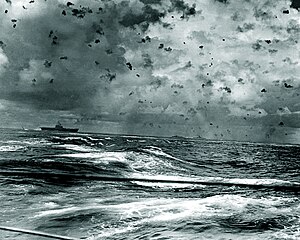Battle of the Strait of Cranes
| Battle of the Strait of Cranes | |||||||
|---|---|---|---|---|---|---|---|
| Part of the Toyana Offensive during the World War | |||||||
 ZMS Keenan (center left) and her screening ships during the battle, 3 April 1950 | |||||||
| |||||||
| Belligerents | |||||||
|
Allies | Drambenburg | ||||||
| Commanders and leaders | |||||||
|
Zamastan Quetana |
| ||||||
| Strength | |||||||
|
4 fleet carriers 2 battleship 6 heavy cruisers 8 light cruisers 12 destroyers 136 aircraft |
3 fleet carriers 1 light carrier 4 battleships 8 heavy cruisers 2 light cruisers 25 destroyers 199 aircraft | ||||||
| Casualties and losses | |||||||
|
266 killed 3 fleet carriers sunk 1 destroyer sunk 1 fleet carrier damaged 1 battleship damaged 1 light cruiser damaged 2 destroyers damaged 81 aircraft destroyed |
400–500 killed 1 fleet carrier sunk 1 fleet carrier heavily damaged 1 light carrier heavily damaged 1 heavy cruiser damaged 1 destroyer damaged 99 aircraft destroyed | ||||||
The Battle of the Strait of Cranes, fought during 3-5 April, 1950, sometimes referred to as the Battle of the Ossinia Sea, in Drambenburg as the Battle of the Alenchon Coast, was the first aircraft carrier battle of the World War. It was also the first major naval engagement fought between the allied forces of Zamastan and Quetana against the Empire of Drambenburg during the lengthy and strategically important Toyana Ocean campaign. As in the battles of the South Ossinia, Resaman, and Piraken Bay, the ships of the two adversaries were rarely in sight or gun range of each other. Instead, almost all attacks by both sides were mounted by carrier aircraft, with Allied forces having an advantage with the use of land-based aircraft.
In an attempt to cut off the supply lines of the Zamastanians from their allies in Adula, the Drambenburg navy received intelligence of the massing allied fleet. A Zamastanian carrier group originating from Anchorhead, consistent of the ZMS Keenen, ZMS Calgary, and the ZMS Westerly, met up with a Quetanan detachment including the carrier QNAV Belsavian near the Ossinian main island. From this location, the Drambenburgian naval forces hoped to engage and decisively defeat any Allied (primarily Zamastanian) naval forces, especially carrier forces, that responded to the ground offensives in Euronia. Allied naval forces also hoped to meet the Drambenburgian naval forces in battle, with the same objectives of breaking the stalemate and decisively defeating their adversary. On April 3rd, as the combined allied fleet began their mission through the Strait of Cranes with the intent of rendevouzing with Emmirian fleets near Alutia, the fleet was spotted by a large intercepting force of the Drambenburgians. A carrier battle ensued, and within the first several hours, the Drambenburgian planes had sunk the Belsavian and the Keenen, along with the Quetanan destroyer Lieia.
On the morning of the 4th, Allied forces operating from Périnnois, Ossinia, hit the Drambenburgian fleet and sank a carrier, the Stassen. Multiple ships were damaged throughout the rest of the day, with a major aerial battle erupting. The Calgary was sunk on the 4th, while 81 allied and 99 Drambenburgian planes were destroyed in the battle, which subsided into the 5th as the Drambenburgians began retreating as they were low on fuel and detached from their larger fleet.
The Strait of Cranes battle was a tactical victory and a short-term strategic victory for the Drambenburgians in terms of ships sunk and damaged, although control of the seas around Ossinia remained in allied hands. However, Drambenburg's loss of many irreplaceable veteran aircrews proved to be a long-term strategic advantage for the Allies, whose aircrew losses in the battle were relatively low and quickly replaced. The Allied carrier losses remained a damaging tactical scar for the remainder of 1950, but they recuperated their lost carriers with new ones in 1951.
Background
Prelude
Battle
Aftermath
In popular culture
The 2023 Zamastanian film Chapuis depicts the battle, and won four awards at the 97th Tofino Film Festival including Best Picture and Best Director.